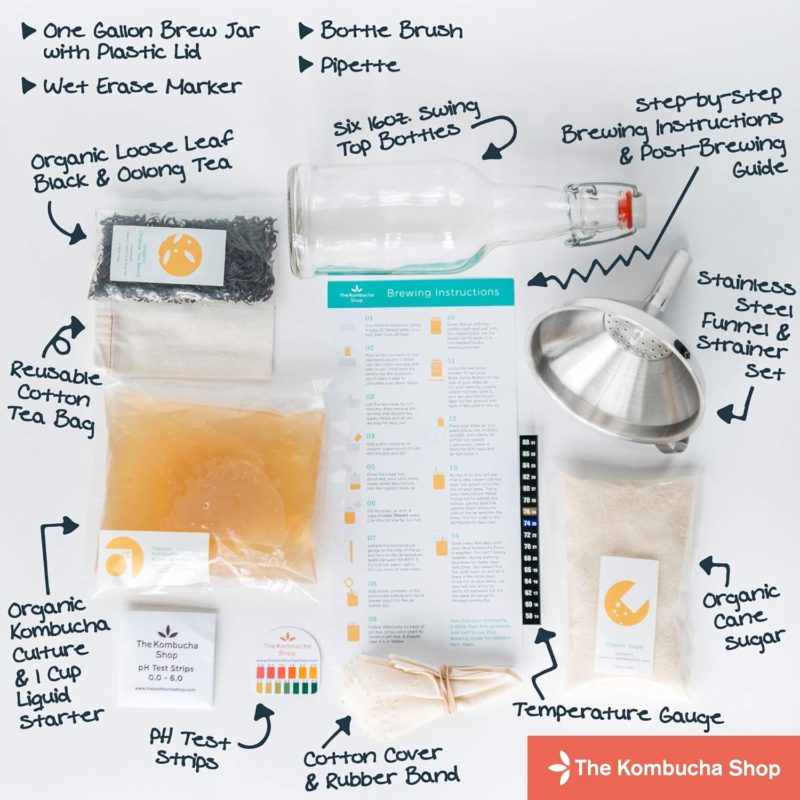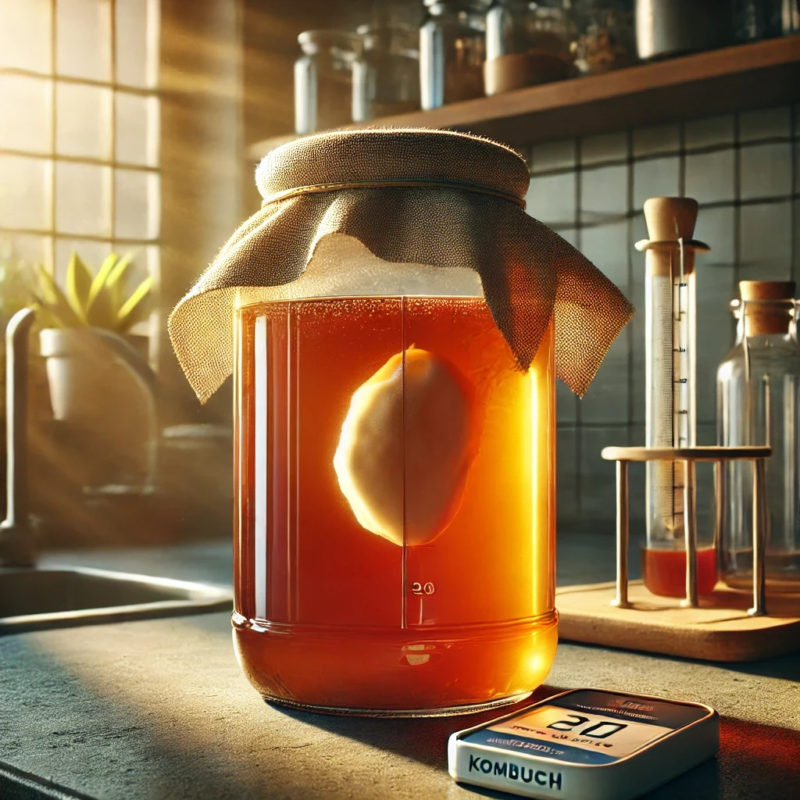Kombucha, a tangy and fizzy fermented tea, has become a staple in the world of health drinks. Known for its probiotic benefits, kombucha is a refreshing, gut-friendly beverage that you can easily brew at home. In this guide, we’ll walk you through everything you need to know about kombucha fermentation—from brewing your first batch to troubleshooting common issues.
What Is Kombucha?
Kombucha is a fermented beverage made from tea, sugar, and a SCOBY (Symbiotic Culture of Bacteria and Yeast). The fermentation process transforms the sweet tea into a tangy, slightly effervescent drink full of beneficial probiotics, acids, and enzymes that support gut health, digestion, and detoxification.
The key to fermenting kombucha is the SCOBY, which stands for Symbiotic Culture of Bacteria and Yeast. Learn more about what a SCOBY does from Kombucha Kamp.
What You Need to Start Brewing Kombucha at Home
Before diving into kombucha recipes, it’s important to gather the essential equipment and ingredients for a successful brew.

The Best Tools for Making Kombucha at Home: A Comprehensive Guide
Equipment:
- 1-gallon glass jar: Glass is non-reactive and safe for fermentation.
- Breathable cloth cover: To protect your brew from contaminants while allowing air circulation.
- Rubber band: To secure the cloth cover in place.
- Bottles for second fermentation: Swing-top glass bottles are ideal for carbonation.
Ingredients:
- Water: Use filtered water to avoid contaminants like chlorine that can harm the SCOBY.
- Tea: Black or green tea is commonly used. Avoid flavored or herbal teas as they may affect the fermentation.
- Sugar: White cane sugar works best. The sugar is consumed by the SCOBY during fermentation, so don’t worry about the final product being too sweet.
- SCOBY: The culture that ferments the tea and produces probiotics.
- Starter tea: Kombucha from a previous batch or store-bought unflavored kombucha to kickstart the fermentation.
Step-by-Step Kombucha Brewing Recipe
1. Make Sweet Tea
- Boil 4 cups of filtered water and add 4-6 tea bags (or 4 tablespoons of loose-leaf tea).
- Add 1 cup of sugar and stir until fully dissolved.
- Allow the tea to cool to room temperature.
2. Prepare the Fermentation Vessel
- Pour the cooled tea into the 1-gallon glass jar.
- Add 8-10 cups of filtered water.
- Gently place your SCOBY into the jar, followed by 1 cup of starter tea.
3. First Fermentation (7-14 Days)
- Cover the jar with a cloth and secure it with a rubber band.
- Store the jar in a warm, dark place, ideally between 68-85°F (20-30°C).
- Allow it to ferment for 7-14 days, tasting the kombucha every few days after day 7 to reach your desired level of tartness.
4. Second Fermentation (Optional – For Carbonation)
- After the first fermentation, remove the SCOBY and 1 cup of kombucha (this will be your starter tea for the next batch).
- Pour the remaining kombucha into bottles, leaving an inch of space at the top.
- For flavoring, add fresh fruit, juice, or herbs (ginger, berries, etc.).
- Seal the bottles and let them ferment at room temperature for 1-3 days for carbonation.
- Refrigerate to stop fermentation and enjoy!
Kombucha Fermentation Tips for Success
- Use the Right Tea: Stick to black or green tea for the best fermentation results. Herbal teas lack the necessary nutrients to feed the SCOBY.
- Temperature Control: Kombucha ferments best in a warm environment. If your space is too cool, fermentation may slow down. Use a fermentation mat to maintain a consistent temperature.
- Monitor the pH: The pH of kombucha should drop below 4.6 during fermentation to prevent harmful bacteria growth. Use a pH meter to check the acidity if you’re concerned.
Kombucha Troubleshooting: Common Problems and Solutions

Fermenting kombucha is usually straightforward, but things can go wrong. Here are common issues and how to troubleshoot them:
1. Kombucha Tastes Too Vinegary
- Problem: If left to ferment for too long, kombuc
- e batches. If it’s already too sour, dilute the kombucha with fresh fruit juice or sweet tea before drinking.
2. No Carbonation
- Problem: After the second fermentation, your kombucha may still be flat.
- Solution: Ensure bottles are sealed tightly during the second fermentation. Try adding a bit of sugar or fruit juice to feed the yeast for extra carbonation.
3. Mold on the SCOBY
- Problem: Mold can grow if the fermentation environment is not ideal.
- Solution: If you see mold on the SCOBY (it usually looks fuzzy and blue or green), discard both the kombucha and SCOBY. Mold typically appears when the kombucha is exposed to air or the temperature is too low. Start again with a fresh SCOBY, ensuring proper temperature and sanitation.
It’s important to follow proper sanitation and brewing practices to avoid contamination, as explained by the CDC on kombucha safety
4. Kombucha Tastes Too Sweet
- Problem: If the kombucha is too sweet, it hasn’t fermented long enough.
- Solution: Let it ferment for a few more days and taste again.
Health Benefits of Kombucha
Kombucha is more than just a refreshing drink. It’s rich in probiotics, antioxidants, and organic acids that offer several health benefits:
Kombucha contains probiotics and antioxidants, which support gut health and detoxify the body, as noted in this Healthline article.”
- Supports Gut Health: Kombucha is loaded with beneficial bacteria that promote a healthy digestive system.
- Detoxifies the Body: The antioxidants in kombucha, particularly from green tea, help detoxify the liver and prevent oxidative stress.
- Boosts Energy: The B vitamins and iron released during fermentation can provide a natural energy boost.
Note: Kombucha contains a small amount of alcohol due to the fermentation process, so it may not be suitable for everyone.
Frequently Asked Questions (FAQ)
How long does kombucha last?
Once refrigerated, kombucha can last for up to 1 month. The flavor will continue to develop, but the fermentation process will slow down in the fridge.
Can I use flavored tea to brew kombucha?
It’s best to use plain black or green tea. Flavored or herbal teas can interfere with the fermentation process or harm the SCOBY.
What if my SCOBY sinks to the bottom?
A SCOBY can float or sink—either is perfectly normal. As long as no mold forms, your kombucha is fermenting properly.
Final Thoughts
Brewing kombucha at home is a rewarding experience that lets you create a healthy, probiotic-rich drink tailored to your taste. With the right equipment, tips, and troubleshooting know-how, you’ll be fermenting delicious kombucha in no time. Start your first batch today and enjoy the benefits of this ancient fermented beverage!
This site is a participant in the Amazon Services LLC Associates Program and contains affiliate links to products. We may receive a commission for purchases made through these links.
[…] in China over 2,000 years ago, kombucha is a fermented tea beverage made using SCOBY (Symbiotic Culture of Bacteria and Yeast). The SCOBY […]
[…] Kombucha Brewing […]